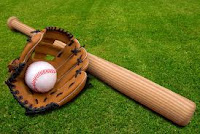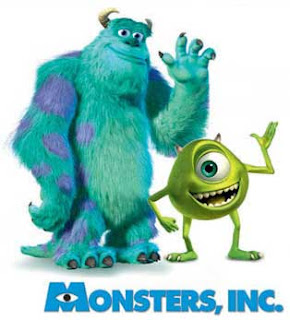No matter the age group you are working with, please remember that including cooperation into the game is very important. By playing games that require the students to work together, you are ensuring that children are not being left out during the activity!
For Elementary Students:
Monsters Inc. Musical Chairs:
Everyone knows how to play the classical game of
musical chairs but this is a version of it that young
children will love. It is geared towards Kindergarten
students to about grade 2 or 3. Most children have
seen the movie "Monsters, Inc." if they have not, just
explain to them that they are going to all be little
monsters and will be jumping into closets. There will
be hula hoops laid out around the gym floor and they
will all have to run around these hoops (hopping,
skipping, jumping etc.) while music plays in the
background (maybe some monster-like music to get
the kids excited!) When the music stops, they are to
jump into one of the closets (a hula hoop) and
GRRRRRR or RAWRRRR like a monster.
Throughout the game, the teacher/leader will be
removing "closets" so that there is no longer one
closet/child. In order to keep children from getting
excluded in this game it is important to let them all
know prior to playing that they should be inviting other
children into the same closet as them if there are not
any left for them. To get them motivated to do so,
you can tell them that the more monsters they have
to "GRRRRR" the more bottles of screams they can
fill (like in the movie).
KIDS LOVE IT WHEN YOU INCORPORATE
OBJECTS OR SHOWS THAT THEY LIKE!!
Equipment Needed:
Hula Hoops - as many as there is children to begin with
CD Player- preferably a monsters inc soundtrack or something similar.
Secret Handshake:
This is a great game for children to get to know each other
better or even just a fun game that incorporates teamwork! It
is geared towards elementary children grade 3 to 5. At the
beginning of the class, students will be paired up. They
pair will then pull three words or phrases out of a bag that
the teacher has previously put together. Using all three
of these words or phrases (ie. crab walk, hands, feet) , the
duo will then have 5 minutes to come up with a "secret
handshake" using all three, in any order that they please.
The students must use cooperation with this game and need
to be able to repeat this handshake at least three times prior
to their 5 minutes being up. At the end, all students will have
a chance to show off the secret handshake that they have
come up with to the rest of the class. It is a very fun game for
yourself and the other children to see what kind of creativity
was put into each of these handshakes.
COOPERATION IS KEY!
Equipment Needed:
A timer or clock to keep track of the 5 minute mark
A whistle to signify when they have run out of time
A bag full of phrases/words prepared prior to class
(This depends of the amount of students, 3/pair)
For High School Students:
This game is derived from the series on TV about having
to work together as a team in order to win challenges and
move further towards winning a set amount of money. To
incorporate this into a gym activity you would begin by
dividing your students into four teams which will be the "tribes"
(do more tribes if it is a very large group). The idea behind
it is that the tribes are stranded throughout the "wilderness"
(the gym), and are given only the essentials: 4 challenge
cards, 1 raft (mat), 1 arrow (ball), 5 logs (noodle pieces),
and whatever it is you have for equipment that they could
build a "shelter" with. An obstacle course of your choice
will need to be set up in advance for the tribes to go through
(make sure it is a large enough course as to not make it
too easy regarding the age you are working with).
The tribes all have 30 mins to complete the challenge
cards given in order to gain the resources of water, food,
fire and shelter in order to survive. They can be obtained
in any order and once the time is up, the tribes who have
successfully completed all challenges will move on to the
final Survivor team challenge!! In this challenge, the tribes
must use their cooperation skills to get all members
through the obstacle course as fast as they can. The first
team to have every member at the end will be the
"Sole Survivors!"
A VERY FUN AND EXCITING GAME
WHERE NO ONE WILL BE EXCLUDED!
Equipment Needed:
16 Challenge Cards (4 food, 4 water, 4 fire, and 4 shelter)
4 Soft balls, small-med sized
4 large water jugs/containers
4 pictures of food
4 pictures of fire
4 gym mats
12 jump ropes
4 sets of 2 small cones with rope spread from one cone to the other
and whatever equipment you have available to create 4 "shelters"
Please note that the obstacle course created can be changed around to whatever equipment is available or what you believe your students would like best.
Mystery Puzzle Race:
The objective of this game is to split up the class into 6 teams
and have them work together in order to finish the tasks. The tasks
will include both physical and intellectual abilities. There will be cones
set up throughout the gym and under each cone will have an index card
with a physical activity on one side (ie. 25 jumping jacks), and a
vocab word that has to do with a sport (ie. home run or a bump etc.)
6 Hula Hoops will be placed around the gym and each team
will be given their own coloured hoop. This will act as the teams
"base" and after performing each task found under a cone,
they must have all team members back to the hoop prior to
going on to the next cone/task. In order to promote teamwork,
the teams must link each member while leaving the hoop. If
this link is broken they must go back and try again. As well,
at each cone, the physical activity must be completed by ALL
members prior to looking at the vocab question. If you need
to make the game more difficult you can try moving the cones
around the gym so it takes longer for teams to find the task they
have not yet completed. The first group to do all tasks is
considered the group winner of the game!
GREAT FOR YOUNGER HIGH SCHOOL GRADES!
Equipment Needed:
15-20 cones (depending on the difficulty required)
15-20 index cards (depending on the number of cones)
6 Hula Hoops, all different colours
6 Score Cards with all 15-20 tasks on them (so students can keep track)
**ALWAYS REMEMBER TO TALK TO YOUR STUDENTS ABOUT THE IMPORTANCE OF COOPERATION AND HOW WORKING AS A TEAM WILL BENEFIT EVERYONE **













